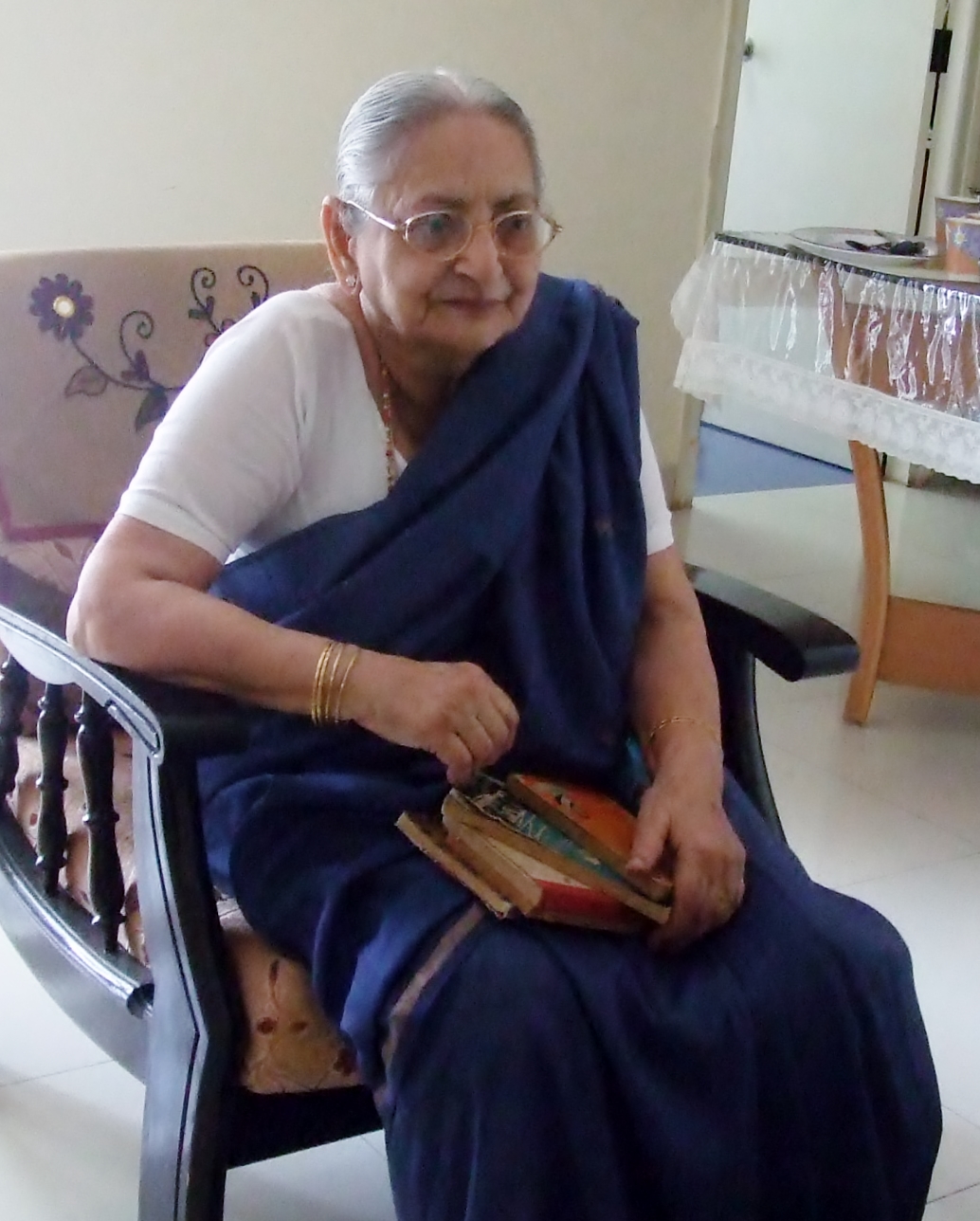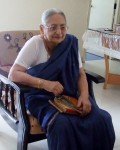Sivaraju Subbalakshmi (b. 17 September 1925) was married at the age of twelve to another famous Telugu writer, Buchibabu [pseud.] (1916-1967), 21 at the time. She hails from Rajahmundry, a town known for its rich literary heritage. She was the second of three daughters and three brothers to her parents. She adopted her brother’s son, who named after her husband, Venkata Subba Rao.
“I am eighty-four,” She said with a charming smile. I visited her at her home in Bangalore, on August 23, 2009. My friend, V.B. Sowmya, was the photographer for us.
After Bucchibabu obtained his Bachelor’s degree, the couple moved to Madras. They started their life together when Buchibabu moved to Madras to do obtain his Master’s degree. In Madras, the couple made friends with several esteemed writers, which contributed immensely to literary pursuits. Subbalakshmi fondly remembers the good times she had with her husband until his untimely demise in 1967.
In 2006, I talked with her over the phone for the first time. She was in Bangalore and I was in Hyderabad. In September 2009, however I happened to go to Bangalore and so took the opportunity to meet her.
She has a pleasant personality. She welcomed us with a big smile, made tea for us, and showed us her room and her paintings. She says Bapu, a highly acclaimed artist of our times, is her nephew (Bucchibabu’s brother’s son) and has taught him how to draw.
Subbalakshmi started writing short stories in the mid-fifties. She quoted a famous writer, Jalasutram Rukmininatha Sastry as saying, “I like your stories better than that novel [of her husband].” I asked her what that novel was and she replied with a hearty laugh, “By then, chivaraku migiledi (by Buchibabu) had been already published.” Another famous poet and university professor, Pingali Lakshmikantam paid her a charming tribute in his asirvachanam [Blessings] (Preface to one of Subbalakshmi’s anthologies). He commented that Subbalakshmi’s stories came from the heart and she wrote from a perspective that only women could understand and portray. Regarding her style, Lakshmikantam stated, “Nowadays, the stories, published now, are hard to distinguish between the stories written by male and female writers. The specialty in Subbalakshmi’s stories is that, the feeling we would feel; only women can write like this. A man, however talented he is, can describe the woman’s nature only as he percepted it; he can only see through his masculine eyes. It is no surprise that when a woman describes the nature of another woman, the description will be far from exaggeration and closer to truth. We can say the objective of these stories is to hold mirror to the human nature filled with jealousies, intolerance and narrow selfishness; they make our world a better place.” He finished his “Blessings” hoping she would write better stories than her husband.
Subbalakshmi credits her inspiration and success to her husband. She says in her preface to her anthology, Sivaraju Subbalakshmi Kathalu, addressing her husband, “You wrote a story and I wrote one. You painted and I painted.” It would appear they had an ideal marriage.
Subbalakshmi has published four volumes of short stories and three novels. One of the three novels, neelam getu ayyagaru [The owner of a house with blue gate] has received critical acclaim. It illustrates a wealthy family who live in a big mansion with blue gate; it is narrated from the perspective of a maid in the mansion, Ponni.
The author has done a marvelous job in capturing the perceptions of an illiterate working woman. The character comes alive.
In our conversations, Subbalakshmi has mentioned that she has stopped descriptions in order to avoid the possible criticism that she was imitating her husband. I am not sure at what point she has changed her style.
Nonetheless, her creativity is obvious in her stories. For instance, the novel under reference opens with the following lines:
The white rose in clusters presents themselves through the blue gate and make the passersby stop for a moment at least. Far off, Ponnamma, who lives in a hut in the open arena, has been going around looking for work, along with her daughters. She says on that street one half of the houses belong to her.
In the first line, she has established the specialty of a white rose. Ponnamma also is a woman with unique character. She is a little lamp that stays forever in the heart of the owner of the house with blue gate for ever. She is a servant with courage to claim one half of the houses on the street as hers.
In the next paragraph, the author starts with a line that (Ponni) “would not tell the truth” and continues to narrate briefly the previous incidents which landed Ponni in the present position.
As Ponni was about to open the gate to enter, the owner’s dog jumped on her and tore her sari and pulled apart her skin from the bones. In the same moment a car came in. From a fair-skinned and hefty man in white clothes got out of the car and offered to give her money. Ponni refuses to take his money. The man out of his generous nature tells the driver to take her to the doctor, adding, “If she dies, that will visit up on us.”
Eventually, she is taken in as a maid in that mansion. When the owner decides to spend some time in Nilgiri hills for health reasons, he and his wife invite Ponni to go with them as domestic help. She becomes the confidante for the entire family—the owner, his wife, son and daughter-in-law. She listens to all their stories. They all show concern for her wellbeing. When the owner attempts to make a move on her, she cleverly escapes, saying, “You are a like the Lord Rama [man of integrity]”.
The owner in his final days reflects on his life, he cannot but think of Ponni as his mentor. He is convinced that he had seen several servants but there is none like Ponni.
Subbalakshmi however considers another novel of hers, teerpu [Judgment] as her best work. It was serialized in a monthly magazine, taruna.
Subbalakshmi has firm convictions regarding the woman’s position at home and in society. According to her, kitchen is an important place in the house, and woman has a responsibility to take care of the home; she should never leave home, since there is no place for a woman where she can be safe.
She said at present she has been writing stories when she finds something interesting in the news but does not send them out for publication. She is also writing her autobiography. “This is not just an account like ‘we lived here or there but about my experiences and memories,” she said. She showed us about 12 handwritten pages.
I asked her if she would fair copy them.
“No, I just write as it comes. Too lazy to rewrite,” she laughed. Suddenly I felt nostalgic. Back in the fifties and sixties, that was the way we all had written stories. At the time, there were no computers, no editing and no cut-and-paste facilities.
Subbalakshmi has an amazing memory. At the age of 84, she remembers all the themes and the incidents that inspired her to write in detail.
In response to the question why one writes stories, she says, “For those who can be happy with what they have, the desire to have this or that is low. Yet, their hearts pine for something special to be recognized about them … that her husband should recognize her identity …”, reminiscing her past. He recalls the times when she and her husband sat on the shores of the River Godavari, and he asked, “What do you think of this ending for this story or that story”, and the satisfaction that he had respect for her opinion—that leaves an imprint on her mind forever. ..
The preface to her book reads like that and it gave me a feeling that she has lost herself in her memories and the preface in itself is another piece of creative writing.
Most of the stories are anchored around the lives of middle class women, their struggles, fears, frustrations and their inability to extricate themselves from the tough situations they are stuck, and in the end settle for a compromise.
She has pointed out a few of her stories as her favorite stories to me. However, the one story that captured my attention is aadavaalla pettelo prayaanam [Traveling in a ladies’ compartment]. This story brought to the fore her personality as I found during our conversation in September 2009. As I stated earlier, she is full of zest. That is evident in this story. Therefore, I decided to translate it for you. I hope you’ll enjoy the story as much as I did.
Publications of Sivaraju Subbalakshmi:
Novels:
Adrushta rekha
Neelam getu ayyagaru
Teerpu
Anthologies of short stories:
Kavyasundari katha
Odduku cherina keratam.
Manovyadhiki mandundi
Magatajeevi chivari chuupu
(This article by Nidadavolu Malathi has been published on thulika.net, March 2010.)
Photo of Subbalakshmi garu by V.B. Sowmya.


Wonderful to know of the creators in our previous generations. Thank you.